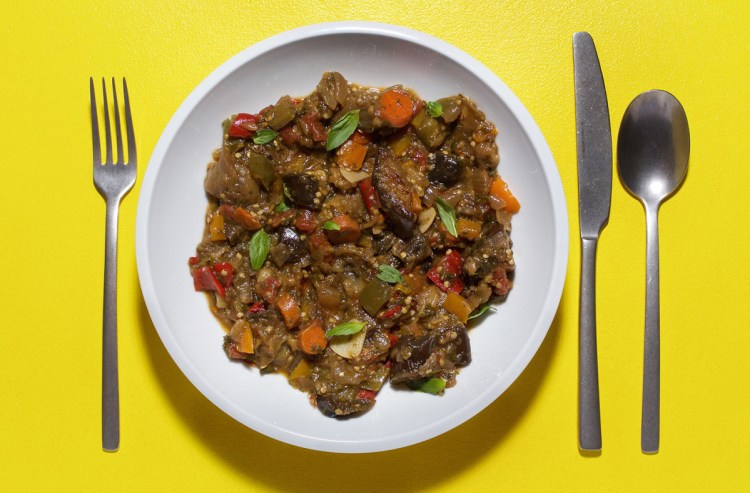In Georgia, there’s a dish that, quite simply, is a genius answer to summer’s most delicious dilemma: the glut of sun-ripened vegetables. If you’re a home gardener, this may sound all too familiar. One second, you’re checking your plots each day, impatiently waiting to reap the benefits of warm sunshine and diligent watering. The next, you can’t pick fast enough, begging friends and family to help relieve the deluge from your overachieving plants.
Or, you’re like me, and can barely keep your windowsill basil plant alive but are a total farmers market junkie. Color-coordinated rows of heirloom tomatoes, crates of carefully stacked, glistening peppers and eggplants, aromatic bushels of herbs with dirt still clinging to their roots. By the time I arrive at the register, any self-imposed budget has been thrown straight out the window and right into the compost. I walk away with a tote bag filled to the brim and the overwhelming question of “What am I going to do with all of this?”
That’s when I make ajapsandali (ad-JAP-sahn-DOLL-ee), which to the Caucasus people is what ratatouille is to the French.
Not surprisingly, it hails from a country, situated east of the Black Sea, whose fecund land provides an overabundance of produce the likes of which many of us will never see. I can pen a love letter to each of Georgia’s vegetarian dishes, but none of them inspires a fervor, and stomach growl, like adjapsandali. Time (i.e. patience) and generous glugs of oil help melt down eggplants, peppers, tomatoes, carrots and onions until they’re transformed into an unctuous vegetable confit. The addition of hot pepper turns it fiery, while cilantro, parsley, basil and garlic elevate it into something particularly toothsome.
Some recipes call for throwing potatoes into the mix, while others will have you add chunks of beef or lamb to make it more of a hearty stew. I find that this version – paired with cucumbers to crunch on, juicy tomatoes wedges to slurp, briny squares of feta, and, of course, torn chunks of hearty bread – is perfect as is.
GEORGIAN RATATOUILLE (AJAPSANDALI)
Ajapsandali (a-ZHAP-sahn-DOLL-ee) is a bit prep-heavy, but once you have all the chopping out of the way, it’s only a matter of letting the vegetables cook down to a jamlike consistency.
Because the spiciness of jalapenos can vary, you might want to taste a small bit of it raw before using, and then adjust the amount in this recipe.
Serve it slightly warm, or better yet, cold with hearty chunks of bread and salty feta.
10-12 servings; makes about 13 cups
3 large eggplants, stemmed, quartered lengthwise, and cut into 1/2-inch slices (about 4 pounds total)
Kosher salt
Sunflower or grapeseed oil
2 large onions, chopped (about 3 cups)
3 large carrots, cut into half moons (about 1 1/2 pounds total)
3 bell peppers (preferably of various colors), seeded and coarsely chopped
1 large jalapeno pepper, stemmed and seeded and finely chopped
3 large tomatoes, peeled, seeded, squeezed of any extra juices, coarsely chopped (about 2 pounds; see NOTE)
4 cloves garlic; 1 pressed/minced, the other 3 thinly sliced
1 1/2 cups cilantro, finely chopped (leaves and tender stems)
3/4 cup fresh parsley leaves, finely chopped
Leaves from 4 or 5 basil sprigs, stacked, rolled and cut into thin ribbons (chiffonade)
Place the eggplants in a colander (or two) set in the sink, then toss with 2 teaspoons of the salt. Let them sit for 30 minutes to 1 hour, then gently squeeze out excess moisture.
While the eggplants are draining, prep the rest of the vegetables: Heat a few tablespoons of the oil in a large, heavy-bottomed pot over medium-high heat. Cooking in batches, add the eggplant slices and cook for about 10 minutes, turning them, until the both sides are golden brown. Add more oil as needed.
Meanwhile, heat a few tablespoons of the oil in a large skillet over medium-high heat. Once the oil shimmers, add the onions and carrots; cook for 10 to 12 minutes, until onions are translucent and slightly golden. Stir in the peppers and cook for 5 minutes, then add tomatoes. Reduce the heat to medium; cook for 8 to 10 minutes.
Once the last of the eggplant has finished cooking, add all the cooked eggplant back to the pot. Reduce the heat to low. Carefully stir in the onion-tomato mixture. From this point on, be very gentle when stirring the vegetables; over-mixing will result in mush. Cook for 5 minutes, then taste and add more salt, as needed. If you find the tomatoes to be too acidic, add a bit of sugar. Continue to cook (uncovered) for 45 to 60 minutes, gently stirring maybe once or twice to make sure the vegetables aren’t burning at the bottom.
Once the ratatouille has cooked down significantly and is almost jamlike, stir in the pressed and sliced garlic and the fresh herbs. Cook for 5 minutes, and then remove from the heat. Add salt and/or sugar to taste.
Serve warm, or let cool completely before storing.
NOTE: To peel the tomatoes, fill a bowl with ice water. Cut an “X” in the bottom of each tomato and remove the stem. Place in a pot of boiling water for 10 or 15 seconds – no longer. Use a slotted spoon to quickly transfer to the ice-water bath. The skins should simply slip off.
Send questions/comments to the editors.


